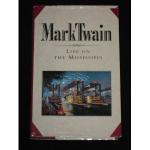As the lecturer remarked, this whole region is blanketed with Indian tales and traditions. But I reminded him that people usually merely mention this fact—doing it in a way to make a body’s mouth water—and judiciously stopped there. Why? Because the impression left, was that these tales were full of incident and imagination—a pleasant impression which would be promptly dissipated if the tales were told. I showed him a lot of this sort of literature which I had been collecting, and he confessed that it was poor stuff, exceedingly sorry rubbish; and I ventured to add that the legends which he had himself told us were of this character, with the single exception of the admirable story of Winona. He granted these facts, but said that if I would hunt up Mr. Schoolcraft’s book, published near fifty years ago, and now doubtless out of print, I would find some Indian inventions in it that were very far from being barren of incident and imagination; that the tales in Hiawatha were of this sort, and they came from Schoolcraft’s book; and that there were others in the same book which Mr. Longfellow could have turned into verse with good effect. For instance, there was the legend of ‘The Undying Head.’ He could not tell it, for many of the details had grown dim in his memory; but he would recommend me to find it and enlarge my respect for the Indian imagination. He said that this tale, and most of the others in the book, were current among the Indians along this part of the Mississippi when he first came here; and that the contributors to Schoolcraft’s book had got them directly from Indian lips, and had written them down with strict exactness, and without embellishments of their own.
I have found the book. The lecturer was right. There are several legends in it which confirm what he said. I will offer two of them— ‘The Undying Head,’ and ’Peboan and Seegwun, an Allegory of the Seasons.’ The latter is used in Hiawatha; but it is worth reading in the original form, if only that one may see how effective a genuine poem can be without the helps and graces of poetic measure and rhythm—
Peboan and Seegwun.
An old man was sitting alone in his lodge, by the side of a frozen stream. It was the close of winter, and his fire was almost out, He appeared very old and very desolate. His locks were white with age, and he trembled in every joint. Day after day passed in solitude, and he heard nothing but the sound of the tempest, sweeping before it the new-fallen snow.
One day, as his fire was just dying, a handsome young man approached and entered his dwelling. His cheeks were red with the blood of youth, his eyes sparkled with animation, and a smile played upon his lips. He walked with a light and quick step. His forehead was bound with a wreath of sweet grass, in place of a warrior’s frontlet, and he carried a bunch of flowers in his hand.
‘Ah, my son,’ said the old man, ’I am happy to see you. Come in. Come and tell me of your adventures, and what strange lands you have been to see. Let us pass the night together. I will tell you of my prowess and exploits, and what I can perform. You shall do the same, and we will amuse ourselves.’




